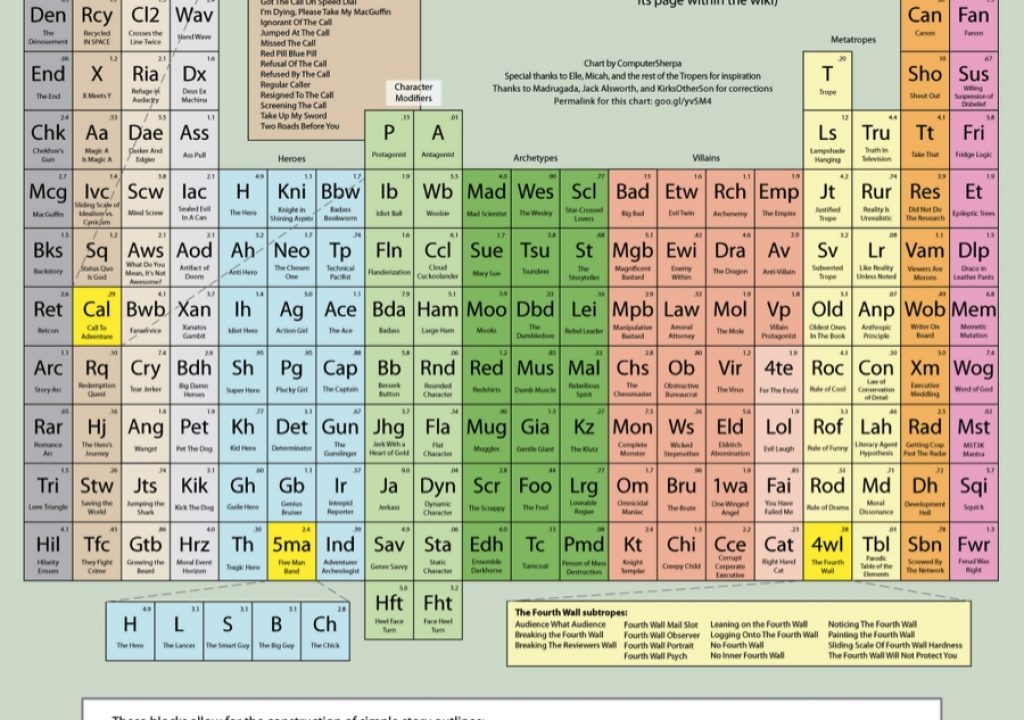Let’s say you’re a film student or filmmaker and you’re interested in telling a story that will stay with your audience beyond the ‘Fade Out.’ Let’s say you want a webisode to go viral. Or, a couple of years ago, you heard Disney and Fox talking about transmedia. Now you’re wondering how to stay on trend with these big distribution companies. How would you even begin to write, shoot, and produce a story that is ‘transmedia” ready?
Here are 4 easy steps to Transmedia Screenwriting:
- 1) Create a ‘Story World.
- 2) Create ‘Mystery Boxes’ within that world.
- 3) Master the anatomy of the viral video.
- 4) Shift your emphasis from storytelling to story making
1. CREATE A STORY WORLD
“The Periodic Table of Storytelling” reveals the elements of telling a good story. In the same way Dmitri Mendeleev designed the original periodic table – a graphic representation of all the basic building blocks of the universe – artist James Harris created a graphic representation of all the building blocks for a story universe: the Periodic Table of Storytelling.
Harris has taken all the tropes; archetypes and clichés found in movies, TV, comic books, and literature and synthesized them into an elegantly realized chart.
Of all these ‘story molecules’, the orphan model (the Star Wars molecule) has proven to be the most popular way to initiate a transmedia story world. In the states, Star Wars was considered one of the first and most influential transmedia story worlds.
This model is often used by J.J. Abrams. Many, like Pont, talk at length about J.J.’s transmedia genius.
Here are some examples of the orphan model:
It doesn’t hurt to throw a love triangle in there too: like Hunger Games (page 8).
Once you have developed this model, begin placing mystery boxes all around. This will help your story world link out into other media platforms.
2. CREATE MYSTERY BOXES WITHIN THAT WORLD.
Pratten made a good chart showing the different directions these mystery boxes can take you in your story world.
Mystery Box is a term I’ve co-opted from the J.J. Abrams Ted Talk of the same name.
Each character in the orphan model has immeasurable opportunity for mystery boxes. Here are some examples:
- Who is the orphan’s father?
- Why is the villain bent on destruction?
- Why are the outcasts outcasts?
- What-all powers do the MacGuffin(s) hold? How many are there?
You do not have to even ‘know’ the possibilities of opening the ‘box.’ Eszterhas says, “If you’re writing a mystery, let it be a mystery to you too” (169) and Paul Haggis always tries to write towards questions instead of answers.
Below are some examples of boxes and their media platforms for LOST:
- Mystery Box – The Statue: (Lostpedia) Message Boards
- Mystery Box – Oceanic 815: (Find 815) ARG
- Mystery Box – Hanso Foundation: (The Lost Experience) ARG
- Mystery Box – Gary Troup: Tie-in Novel (Bad Twin)
- Mystery Box – (Lost Missing Pieces) Mobisodes
3. MASTER THE ANATOMY OF THE VIRAL VIDEO.
Writer and analyst Kevin Allocca works with YouTube Trends, a spot for tracking the latest viral videos. He connects them to the communities that make the parodies, tributes and reply videos within the ‘viral planets’ of YouTube’s universe.
He’s composed a pretty simple formula worth mastering (for a scene in your show or ads for your story):
Tastemakers + Community Remixing + the Unexpected = Viral Video.
Tastemakers are mostly celebrities, talk show hosts, and news anchors (spend some PR bucks!). Community remixing refers to the fans on the various media outlets: it has to be easy to remix and share. The Unexpected means the story/scene/video itself has to have an M. Night Shyamalan twist in it.
I do not have the data yet but the people at Mullen who made a viral mother’s day video pointed some things out about their video brake down. They introduced a twist 45 seconds in and then their M. Night moment was 3 minutes in. I would suggest making the videos 3-4 minutes and doing the same.
4-minute videos share the best on social sites.
Below are some viral examples from LOST:
- The ‘we have to go back!’ scene
- The ‘who’s in the coffin?’ scene
- The ‘not Penny’s boat’ scene (probably the best)
4. SHIFT YOUR EMPHASIS FROM STORYTELLING TO STORY MAKING.
Encourage fan pages, real-time hashtag conversations with the characters, and wiki forums. The audience members are the story makers and the audience has an audience. The research also shows that 91% of viewers would feel compelled to tune in more often for things happening in real time.
This is the ultimate shift in transmedia screenwriting: writing towards an open culture of crowd sourcing. This is what makes the periodic table so appealing; it is the result of audience collaboration.
As Lan Mochari points out, ‘the big problem with storytelling is it’s a one-way street’ with your script or brand doing all the talking. Web 2.0 changed our world from ‘one to many’ broadcasting to a ‘many to many’ experience.
Transmedia screenwriting isn’t about you broadcasting your message to the masses with a digital media megaphone. It’s about story making, where as D. Berkowitz puts it, the script (or brand) narrative ‘facilitates and taps into the stories people are creating and sharing with each other.’

